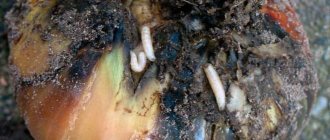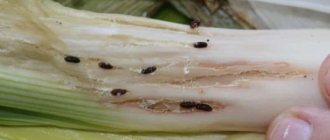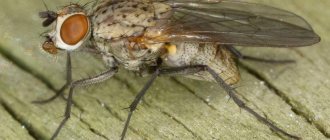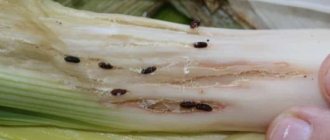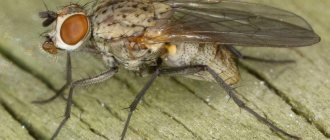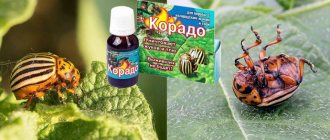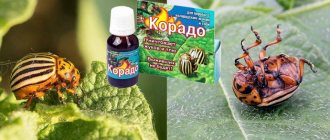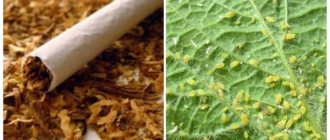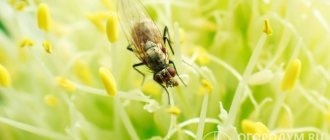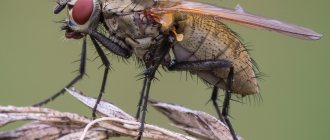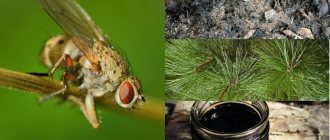Onion fly larvae (Delia antique) are tiny pests of onions and related plants. They feed on bulbs underground, creating tunnels and possibly introducing disease-causing organisms into the plants. Onion fly larvae are very difficult to get rid of, especially where continuous production is practiced. Damage by onion larvae is more common in cool, moist soils.
Onion flies are specific to plants in the onion family, including onions, leeks, shallots, garlic and green onions.
- Why is onion fly damage dangerous?
- What is an onion fly?
- Life cycle of the onion fly pest
- What to do in the spring as a preventive measure against onion flies
- What general rules will help in the fight against onion fly?
- What drugs will help against onion fly?
Why is onion fly damage dangerous?
Light damage does not kill onion plants, but it does make them more susceptible to bacterial rot. The feeding of the larvae can lead to the death of seedlings, so poor plant growth may indicate the appearance of onion fly larvae. In larger plants, the larvae can penetrate the bulb, as a result of which the plants become lethargic and turn yellow, and the bulbs themselves become unsuitable for food.
You can learn how to grow onions from seeds in one year from this interesting article >>>>
Onion damaged by onion fly larvae
Signs of defeat
The following types of signs are identified that indicate the appearance of a type of pest such as onion fly:
- green onion shoots begin to turn yellow;
- an unpleasant fetid odor is formed;
- onion feathers become broken;
- the bulb begins to rot;
- Flying insects can be seen above the beds.
Often, in complex cases of pest infestation, large numbers of larvae can be seen when a damaged bulb is broken.
What is an onion fly?
The onion fly has an ash-gray body and resembles a housefly. They have a humped back, large wings - at rest the wings overlap the body.
Onion fly eggs are oblong in shape, white in color and usually laid in groups on the shoots, leaves and bulbs of host plants and on the ground nearby. The eggs hatch in 3-8 days. The larvae usually stay and feed in groups.
The larvae go through 3 stages that develop over 2-3 weeks before developing into brown, ringed, oval pupae.
Onion fly larva
Fighting methods
To combat the pest, various methods can be used, including traditional ones.
Folk remedies
The advantage of folk methods is their accessibility and lack of harm to culture.
Saline solution
The use of this method allows you to eliminate the pest in the first stages of its appearance. To fight, you need to prepare a saline solution, mix 200 grams of salt in a bucket of warm water. The resulting mixture is used to water the onion rows using the root method. Used once every 2 months.
Potassium permanganate
It is necessary to prepare a solution of manganese by mixing 5 grams in a liter of water. The resulting solution is sprayed onto the plant and the soil in the beds. Can be used every 10 days.
Wood ash
The substance can be used in several ways:
- Mix a kilogram of ash in a bucket of water and spray the plants and soil between the beds. Apply once every 10 days.
- Spread the ash in a thin layer between the beds and on the plants, after watering the area with the onions.
See also
When to harvest onion sets, family and turnips from the garden in the Urals in 2020, timing
Read
Ash repels insects and acts as fertilizer.
Infusion of tobacco dust
You can buy tobacco dust at any store that sells fertilizers and pesticides. Tobacco dust is scattered between the onion beds, the smell of the substance repels the pest. Can be used every two weeks.
Proper destruction of rotten bulbs
It is possible to save the harvest if you remove rotten onions. Carefully remove the bulbs from the soil along with the soil and place them in a container. The beds must be watered first. The onion growth area must be treated with a manganese solution to remove possible larvae. Spoiled onions must be burned immediately after removal from the soil.
Dandelion root
A fresh plant root is used, it is cleared of soil and washed with water. To make the solution, pour a glass of crushed roots into a liter of water and leave for 5 days, then strain and mix with 9 liters of water. Spray every 7 days.
Insecticidal plants
The use of insecticidal plants allows you to repel pests and fight a large number of diseases. These plants include:
- tobacco;
- potato;
- Red pepper;
- yarrow;
- garlic.
To eliminate onion flies, tobacco can be used. The plant is finely crushed and filled with water in a ratio of 1:5. The mixture is infused for 2 days and used to spray the crop.
Birch tar
The recipe for preparing the working solution is simple. To use, you need to stir 10 grams of tar in a bucket of water and add 20 grams of liquid soap. The solution is mixed and used to spray onion beds. Can be used every 15 days.
Ground red pepper
Red pepper has a scent that repels pests. To eliminate pests, it is necessary to scatter ground spice along the beds. This method is considered effective at the first appearance of flies on the onion.
Kerosene
The substance has a strong odor, so kerosene can be used to repel onion flies. To use the method, you need to take a bucket of sand and pour it with kerosene (400 grams). Sprinkle the resulting mixture onto the soil between the beds.
Vinegar
To apply the method, it is necessary to place containers along the beds with onions into which vinegar is poured; when exposed to sunlight, the substance begins to evaporate and repel pests.
Laundry soap
Most often, treatment for onion flies at home is carried out using laundry soap. To prepare the solution, you need to grate a bar of soap on a fine grater and mix it with a liter of warm water; after the soap has completely dissolved, the solution is mixed with 9 liters of water. The solution is sprayed onto the onion beds every 15 days.
"Metronidazole"
The medicinal substance is an antibacterial drug and is used to eliminate fungal diseases and pests. To process onions, you need to grind 5 tablets of the medicinal component to a powder. Mix with 10 liters of water and spray the plant every 10 days.
Ammonia
To use a solution with the addition of ammonia, you must mix the medicinal substance with water in a ratio of 3 tablespoons per 10 liters of water. The resulting mixture is distributed between the beds every 15 days.
Naphthalene
The drug is most often produced in the form of pellets and has a strong odor. To remove onion midges, you need to crush 10 balls to a powder and mix them in a bucket of sand. Sand is scattered between the beds.
Deworming tablets
Anthelmintics have an antibacterial effect and are most often used to remove larvae. It is also recommended to soak the seed with the drug; to prepare the solution, 1 tablet of the medicinal substance is mixed in a liter of water.
Iodine and boric acid
The method has repeatedly proven its effectiveness; to prepare the solution you need:
- Mix half a teaspoon of boric alcohol in 10 liters of water;
- add 3 drops of iodine and 5 grams of manganese;
- stir and add a spoonful of ammonia.
Each onion bush is watered with the solution every 15 days.
Chemicals
The use of chemicals allows you to get rid of the pest in a short time.
"Fly-eater"
The drug contains a component such as diazinon. The active substance blocks larvae and affects adults. Recommended for use when planting bulbs in the ground. The product must be used to treat the soil and seed.
"Aktara"
To use the insecticide, you need to prepare a solution by mixing 1 gram of the substance in 10 liters of water. Spraying is done twice a season.
"Karate Zeon"
The drug acts on the nervous system of pests and leads to their death, and can be used throughout plant growth. To prepare the solution, take 1 gram of the substance per liter of water. Does not affect the taste of the crop.
"Tabazol"
Contains tobacco dust. The package of the substance must be diluted in a bucket of water and the onion beds must be treated. After 10 days, the procedure is repeated.
"Sochva"
Refers to safe types of insecticides. To prepare a working solution, you need to mix 5 grams of the substance in two liters of water. Spraying is carried out every 7 days until the problem disappears completely.
See also
Description of the Red Baron onion, planting rules and harvesting
Read
Ammonium carbonate salt
It is classified as a fertilizer, but it prevents the development of diseases, including onion flies. For use, it is necessary to disperse the substance in the amount of 60 grams per square meter. Water the field generously with water.
"Medvetox"
The drug is produced in the form of peas and has a specific smell; to combat onion flies, it is necessary to sprinkle the insecticide between the beds and loosen the soil. Allows you to destroy an insect in several applications.
"Zemlin"
The action of the insecticide is aimed at removing pests that most often reside in the soil. Active particles of the substance, entering the pest’s body, destroy it from the inside, which leads to death. Instructions for use contain all the necessary tips for using the drug. The substance is distributed between the beds, after which the soil is loosened; it can be used every 20 days.
"Intavir"
Quickly destroys the pest without harming the plant. To use, you need to mix a tablet of the substance with 2 liters of water. The effect of spraying is noticeable within a day and can be used several times a season.
"Immunophytophyte"
The drug is used once a month to spray onion beds. To prepare the solution, you need to dissolve 2 tablets in 2 liters of water and spray the plant. It affects not only the larvae, but also the eggs of insects.
Important. To obtain a visible result, it is necessary to add liquid soap to the insecticide solution to adhere the active substances to the onion shoots.
"Diazinon"
It is used to eliminate all types of harmful insects; upon contact with pests, it tends to penetrate the body and lead to death. To use, you must follow the instructions for use. The product can negatively affect a person’s well-being. Therefore, when processing onions, it is necessary to use personal protective equipment.
"Creolin"
The use of “Kreolin” is a very common procedure for the preservation of onion beds. To use, you need to prepare a solution by mixing a spoonful of the substance with a bucket of water. The procedure is repeated after 21 days; personal protective equipment must be used during treatment.
"Bazudin"
Suitable for general cultivation only. During the growing period, the substance is not used for feathers. You need to mix 30 grams of the substance with a bucket of sand and distribute it over the onion area.
"Alatar"
Used for complex cases of onion damage by insects. To prepare the solution, mix 5 ml with 10 liters of water. The resulting composition is sprayed over the onion area. Spraying is carried out in the evening.
"Spark double effect"
Destroys larvae that have appeared in large numbers. The pesticide is used against all types of pests. For onions, you need to prepare a solution by mixing 10 ml in a bucket of water. The resulting composition is sprayed on the ground part of the onion every 15 days.
The drug "Moveton Nova"
Penetrates into the body of insects and leads to death; to use, you need to prepare a solution by mixing 10 ml of the substance with 10 liters of water. The beds are processed 2 times a season.
Agrotechnical methods
Using the rules of agrotechnical care reduces the risk of insect occurrence and allows for timely detection of infestation.
Loosening
Effective for beds that do not have visible lesions. During loosening, the soil is saturated with oxygen and the moisture level decreases. Such factors negatively affect the pest larvae. Loosening is carried out every week.
Weeding
Good protection of crops from pests is timely removal of weeds. Weeds can act as carriers of onion fly eggs. Weeding should be done every 2 weeks.
Thinning
In dense plantations, onions are weak and easily susceptible to disease. To reduce the risk of insects, thin out the beds, leaving only strong specimens.
Destruction of affected plants
A damaged bush can infect other plantings in a short time. The plant should be carefully removed and the growth site should be treated with an antiseptic. Such bushes have visible symptoms of infection and when removed from the soil, a gray coating is noticeable and larvae are visible.
Fertilizing with urea in May
Urea contains components that negatively affect insects. To use, prepare a solution by mixing chalk, urea and copper sulfate one tablespoon at a time. The resulting composition is dissolved in 10 liters of water. Apply to onion beds.
Life cycle of the onion fly pest
Onion fly larvae overwinter as pupae in the soil. Adult onion flies emerge around mid-May, after which the females begin laying eggs. The larvae, having hatched, crawl under the leaf sheath and penetrate the bulbs. After a few weeks they pupate and the next generation of adults emerges 3-4 weeks later. There are usually 3 generations per year, the first of which is the largest and often the most destructive. The full cycle takes from 45 to 65 days.
Signs of the presence of a pest in the garden
It is difficult to see the larvae, since they do not crawl to the surface of the soil unless absolutely necessary. But from the appearance of the plants, it is immediately clear what kind of pest has attacked your garden: the plants develop unusually slowly, their feathers turn yellow and wither, and they also begin to smell disgusting. The bulbs become soft and loose to the touch, and a rotten coating is noted. They cannot be eaten.
What to do in the spring as a preventive measure against onion flies
1. Use yellow sticky traps in the spring when adult onion flies emerge. They can be placed safely in garden beds to catch all pests. Unfortunately, this method will also add some beneficial insects to the trap.
2. Crop rotation is a good practice. Grow onions and related plants in a different location than in previous seasons.
3. Cover seedlings and plants with lutrasil to prevent adult onion flies from laying eggs on host plants. This is a very effective method that must be applied immediately after planting the onions.
Protect spring plantings with lutrasil
4. Since the 1st generation onion larvae are the largest and most dangerous, plant onions as late as possible. Or plant onion plants at the very beginning of spring, weather permitting, to allow the plants to become stronger before the onion fly emerges.
5. If onion fly is a scourge in your area, grow red onions, rocambole and shallots, which are somewhat resistant to onion fly damage. You can learn about other interesting edible types of onions here >>>.
6. Sprinkle ground cayenne pepper, ginger, dill or chili powder into onion areas to repel females and prevent egg laying. To repel onion flies, you can use a mixture of tobacco dust and chalk sand (1:1), wood ash, mustard, hot ground pepper (1 teaspoon per 1 liter jar of dry sand) or peat. They sprinkle the soil along the rows 2–3 times per season.
7 If a small area of your garden is infested with onion fly larvae, get rid of the soil. If the area is too large, wet it with the following mixture. Puree the pepper, garlic and onion in a blender. Add water and green soap and let sit for a day. Strain out the solids and use this liquid to flood the contaminated soil.
8. Buy and add to the soil predatory nematodes (the drug Nemabact, we talked about it in more detail in this material >>>>>), parasitizing insects that fight onion fly larvae, and add them to the soil in accordance with the instructions.
Preventive measures
To prevent the occurrence of the pest, it is necessary to take appropriate measures in a timely manner.
Digging
Digging up the land will help get rid of the pest. Most often, insect pupae are stored in the soil; when digging in the autumn, the soil is disinfected with the help of frost.
Important. The onion fly reproduces quickly. She can lay eggs up to three times during the season.
Boarding time
Choose the right time to plant onions. All varieties of vegetables must be planted in the soil as early as possible, after it has warmed up to the required degree. Onions tolerate low temperatures well, and light frosts will be an additional method of pest control. Autumn is the right time to prepare the site for sowing, so it is necessary to remove all old leaves that may contain larvae.
High-quality planting material
The material for planting onions must be selected very carefully. You should not purchase onions from unverified places. The planting material may contain pest eggs, which, once in the soil, will begin to develop and after a few weeks will appear as a swarm of onion flies. Before planting, it is necessary to treat the seeds with a manganese solution.
Selecting a location
When planting onions, you need to pay great attention to the location of the site. The bed should be in a ventilated place with sufficient sunlight. Also, the crop planting site should not be in places with high humidity, which can lead to the appearance of diseases and pests.
Crop rotation rules
To reduce the risk of pest occurrence, it is necessary to follow the basic rules of crop rotation; onions should not be planted in one area for several years; it is necessary to regularly change crop planting sites.
Also, onions are not planted in places where crops that had the same pests as onions previously grew.
Neighborhood with carrots
Proximity to carrots can protect onions from fly infection. Carrots repel the pest and do not affect the development and yield of onions. It is recommended to alternate onion beds with carrot beds.
Proper watering
Onions need to be watered as the soil dries out; excessive moisture can provoke the formation of rot on the bulbs. Weakened plants are susceptible to pest attacks.
In order to properly water the plant, it is necessary to use watering cans to distribute the liquid evenly, and moistening is carried out until the end of June, after which it stops.
What general rules will help in the fight against onion fly?
To repel adult flies and onion larvae, sand, wood ash and dolomite can be added to the rows.
Growing onions in raised beds with fresh soil or in containers is a good idea as onion maggots like poorly drained soil.
After each growing season of onions and related crops, the soil must be thoroughly tilled to eliminate pupating larvae, remove plant debris, and remove all onions and culls so that there are no areas where onion fly pupae have nowhere to overwinter.
Terms and rules of processing
Since the fly flies specifically at the onion scent, most folk methods are designed to mask the characteristic smell of the plant. The other part creates uncomfortable conditions for the insect to reproduce. And only a small proportion is aimed at direct destruction of larvae.
The fly breeds throughout the summer, so spraying is done regularly at intervals of 5-14 days (depending on the substance, weather and the development cycle of the fly offspring). During intensive flight phases, irrigation is carried out more often (every 3-5 days), at other times - less often.
The first flight occurs at the moment of flowering of dandelions, lilacs, and fruit trees.
The second flight is in 35-45 days.
The third flight is in another 35-45 days.
What drugs will help against onion fly?
The onion larva has many natural enemies, such as ground beetles, birds, parasitic wasps, and nematodes. Try not to use chemicals uncontrollably.
Experts recommend alternating the following drugs: Aktara, Vantex, Sirocco, Muhoed, Force. Carefully read the manufacturer's instructions and do not exceed the recommended dosage.
You can learn how to defeat the carrot fly from this material >>>>>
No. 1. Wood ash
This is the most affordable way to combat onion flies. After watering or rain, ashes are applied to the row spacing at a rate of 100 g/m. and sealed with a flat cutter or hoe. The procedure is repeated every 10-14 days.
On a note. To enhance the effect, for every 100 grams of ash, you can add 25-30 grams of tobacco powder, as well as a teaspoon of hot ground pepper.
Ash infusion will also help protect the plantings. To do this, add 400-500 grams of ash to 10 liters of warm water and leave for 24 hours. After filtration, 30-50 grams of laundry soap are added to the mixture. Consumption is 1-1.5 liters per linear meter of bed.
No. 3. Metronidazole
The well-known antibacterial drug is widely used by gardeners. Including pest control.
The recipe for the solution is simple: 5-10 tablets per 10 liters of water. The onion is processed when the feather height is 5-10 centimeters. It is believed that the larvae die after a single treatment.
Reviews about the method are mixed - the chance that it will help does not exceed 50%.
No. 8. Planting onions with marigolds, carrots, tomatoes
This will help confuse the fly and the pest will not find its way to the onion bed. Onions and garlic are combined with the following crops.
Dill. The spice is sown pointwise between the rows of onions. Or you can first plant the seedlings, scatter dill seeds on top and lightly cover them with a rake. Usually the plants do not interfere with each other, you just need to remember to regularly pull through the greens.
Tomato. Nightshade crops also have a distinct odor that repels flies. To get a good result, it is enough to place the onion bed next to the ground tomatoes.
Carrot. Some gardeners like to alternate rows of carrots and onions in one plot. Yes, this is a beneficial combination in terms of pest control. But you also need to take into account that cultures need slightly different care.
For example, it is advisable to dry the soil under onions 1-1.5 weeks before harvesting, but carrots need watering at all stages of growth. Therefore, it is better to do this: divide the bed into two parts (lengthwise or crosswise, whichever is more convenient) and plant one with carrots, the other with onions.
Marigolds, calendula . Flowers are sown between onion rows, or along the edge of the bed. In this case, the distance between the rows is increased to 40-45 centimeters. This is necessary so that the plants do not shade each other.
Causes and period of occurrence
The bulb fly is difficult to get rid of. It multiplies quickly and spreads into the soil. More often the parasite appears for the following reasons :
- improper crop rotation;
- poorly selected varieties planted next to bulbous crops;
- incorrectly selected period for planting onions (too late);
- no digging of deep layers of soil in the autumn;
- the use of seed material infected with parasite eggs.
Since the larvae mature to the adult stage in July, this is the most likely period for plants to be infected by the parasite. If disinfection is not carried out in time, the disease will spread to neighboring varieties and will progress throughout the summer and subsequent years.
What does it look like
An adult onion fly is very similar in appearance to an ordinary housefly, but is smaller in size: the length of the ash-gray or green-tinged body does not exceed 7 mm. The black legs are covered with thick bristles. The wings are transparent with a yellowish tint. Males have a dark stripe on their bellies.
The female onion fly is very prolific, laying eggs on or near onion seedlings and bulbs in the soil. One clutch can contain up to 200 white elongated eggs. After about a week, white cylindrical caterpillar larvae up to 10 mm long emerge from the eggs. The larvae penetrate into the pulp of the bulbs from the bottom or through the base of the leaves.
One bulb can feed up to 50 caterpillars. After 15-25 days from birth, the larva turns into a pupa. Young flies reappear from the cocoons after 2-3 weeks. At the end of summer, before the onset of cold weather, the pupae do not turn into flies, but go into hibernation in the form of puparia (false cocoons). Puparia overwinter at a depth of up to 20 cm. In addition, adult flies lay eggs in the soil, from which larvae emerge in the spring.
No. 7. Herbal infusions
Wormwood, pine needles and mint
Regular spraying with herbal infusions allows you to successfully hide the onion smell:
- wormwood: 1-1.5 kilograms of fresh chopped herbs per 10 liters of water for 2-3 days;
- dandelion roots: 200 grams per 10 liters of water for 7 days;
- pine needles: 0.5-1 kilogram per 10 liters of water for 5-7 days;
- valerian, mint, wild rosemary, tansy: 500-600 grams per 10 liters for 1-2 days.
To treat a square meter of plantings, a minimum of 2-3 liters of infusion of smelly herbs is required. The frequency of spraying is once every 7-10 days.
Prevention
A saturated solution of potassium permanganate is used to water the beds prepared for planting onions, regardless of whether onion fly larvae and cocoons are found in the soil or not. In order to avoid the spread of the pest, the time for planting onions is chosen when the onion fly has not yet begun to fly. Onions are not afraid of return frosts and will calmly tolerate a short-term drop in temperature to -3-5°C.
The bulbs must be prepared for planting: they are treated either with chemical protection agents, or in a strong saline solution, or in potassium permanganate, or soaked in hot water. Before processing, it is necessary to inspect the bulbs and discard any damaged specimens. It is better to burn heads with traces of pest bites or signs of disease.
When choosing land for onion beds, you need to choose an area where onions have not been grown for the previous four years. Near the beds with onions, it is necessary to plant pest-repellent plants. Plots of soil for onion beds are dug up in the fall, after the onset of cold weather, so that layers of soil with larvae appear on the surface and freeze in the cold.
